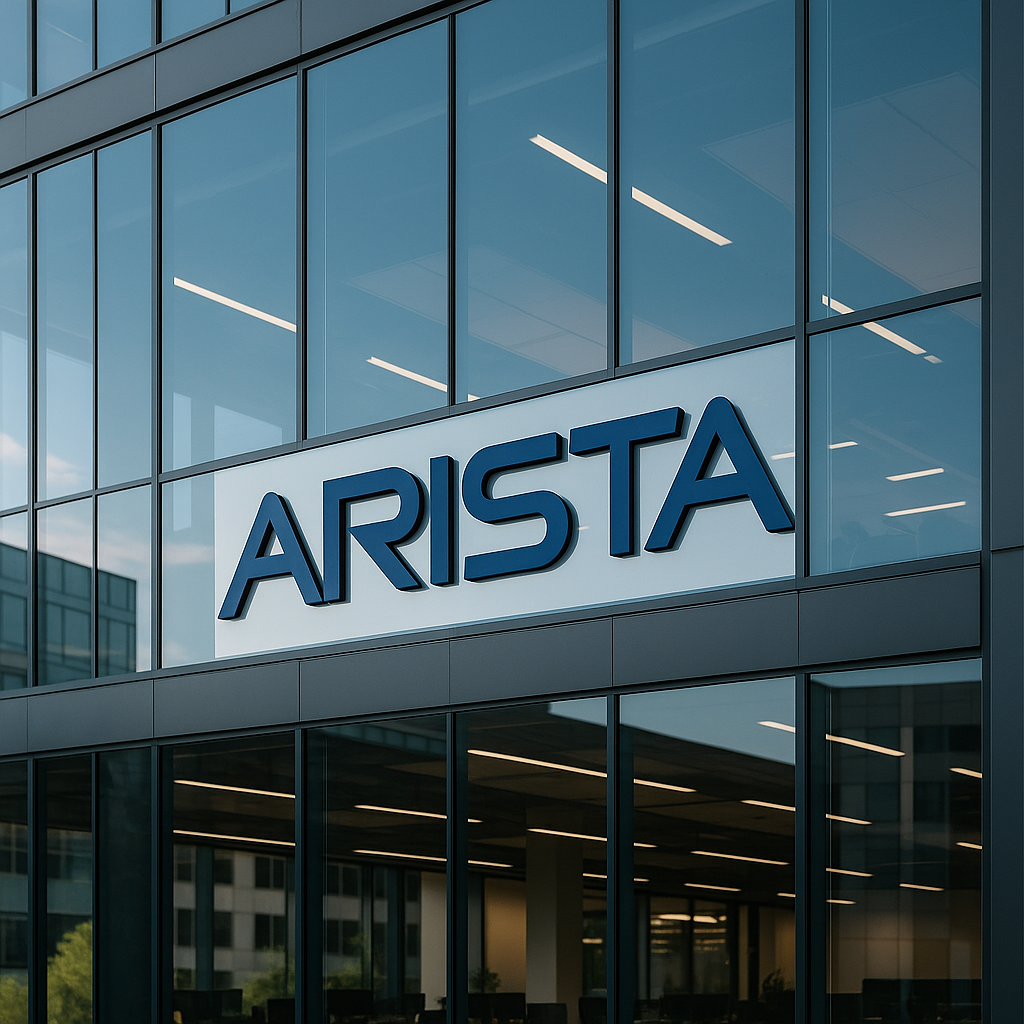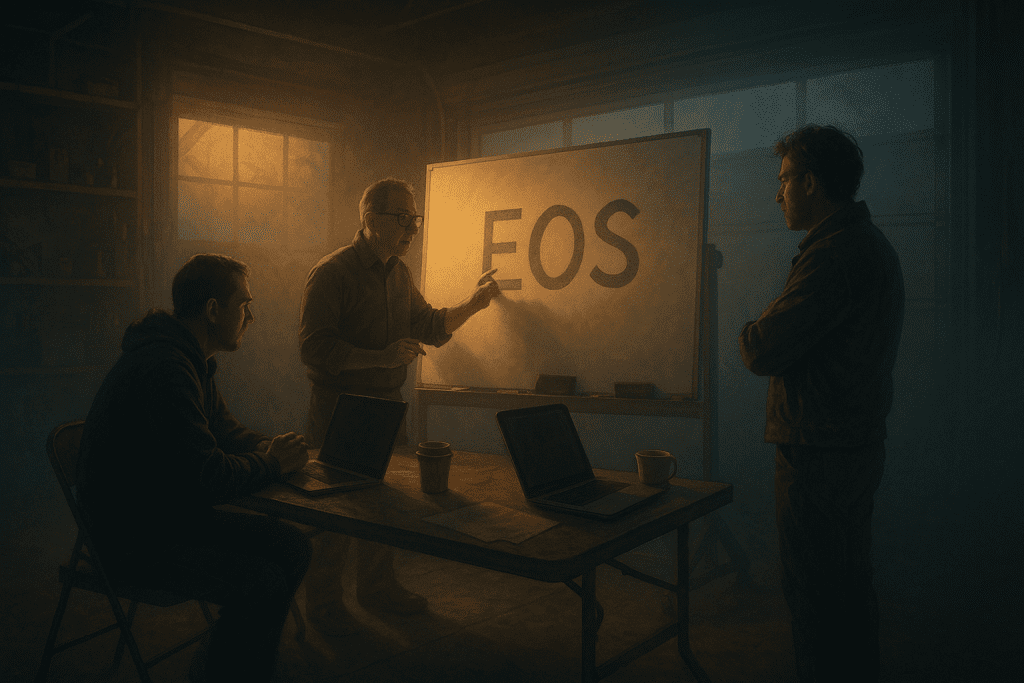
Prologue — Dawn in the Garage (2004, Palo Alto)
The early morning air pushed back the cold fog of Silicon Valley. On a folding desk inside an old garage, a name scribbled like graffiti—Arastra.
Andy Bechtolsheim wrote two large letters on the whiteboard: “OS.”
Next to him, David Cheriton folded his arms, and Ken Duda flipped open his laptop.
“Hardware will one day be commoditized,” Andy said. “What we must hold onto is the operating system that drives the entire fabric.”
David nodded. “The cloud is coming. To control that river, the network OS must sit at the center.”
Ken chuckled. “On that OS, automation will run, and even if an agent crashes, the state will remain. That’s the essence.”
That night, they chose software as the backbone of the company. A few years later, Arastra would change its name to Arista Networks. (Founded 2004 as Arastra, renamed Arista in 2008, IPO in 2014.)
Part I — The Birth of EOS (2008–2010)
Chapter 1. Jayshree’s Whiteboard
In a temporary office in Santa Clara, steam rose from paper cups of coffee on a standing desk. Jayshree Ullal wrote four letters on the board: “E O S.”
“Extensible Operating System,” she said, her voice low and clear. “We don’t want to be called just a ‘switch maker.’ We’re building a network operating system.”
An engineer raised his hand. “What about the kernel?”
“Linux,” Jayshree replied. “A multi-process architecture, with all state gathered in a brain we call Sysdb. If an agent fails, the state persists, and when it restarts, it picks up where it left off. Even upgrades can run in service.”
Another engineer muttered, “So a failure becomes just an event, not a collapse.”
She smiled. “Exactly. Operations will begin to speak the language of software.”
From that day, the principle of “one single binary image across all hardware” became the creed of EOS.

Chapter 2. The First Customer’s Second Hand (Chicago — Colocation Floor)
In a Chicago exchange colocation room, the air was cold, and server fans ticked like a clock.
A high-frequency trader asked the Arista team, “Forget milliseconds—can you talk in microseconds?”
The engineer silently pointed to the switch at the top of the rack. “Let’s try.”
After testing, the order flow graph shot up like steps on a staircase.
“My heart… is faster,” the trader whispered.
That night, the Arista team clinked paper coffee cups in a hotel lobby. “Low latency” wasn’t just a metric—it was their first true imprint.
Part II — A Name and a Stage (2014)
Chapter 3. The Ring of the Bell
New York Stock Exchange, June 2014. Ticker ANET lit up.
“IPO price $43. Strong demand on the first day,” whispered the CFO.
Jayshree steadied her breath. “This is the IPO of software. Not selling boxes, but the language of operations.”
Cameras flashed, confetti fell from the ceiling. After a brief celebration, silence settled in. The real stage had just begun.
Part III — The Season of War (2014–2018)
Chapter 4. Piles of Paper and Silence
Late at night, the legal team dropped thick stacks of documents on the table.
“Cisco has filed a patent infringement lawsuit.”
The room went still.
An engineer spoke up. “We may have to rewrite CLI syntax. Change the commands customers are used to.”
Jayshree slowly nodded. “We’ll do it. We’ll face it head-on.”
After years of courtroom battles, the summer of 2018 brought a settlement.
“We will pay $400 million, keep necessary changes, and move forward,” read Jayshree’s short internal email.
Someone asked, “Did we win or lose?”
She answered, “We chose the road forward.”
When the legal storm passed, the engineering floor felt eerily quiet. Everyone knew: if you endure, engineering becomes stronger.
Part IV — Expanding the Map (2018–2020)
Chapter 5. The Breath of Wi-Fi (Mojo Networks)
A summer afternoon, Arista’s meeting room. A new team sat across the table—Mojo Networks.
After explaining cloud-managed Wi-Fi, an Arista PM asked quietly,
“Will EOS’s language now speak in campus networking too?”
Jayshree smiled. “That’s exactly why. To unify the grammar of campus and data center.”
Chapter 6. The Mirror and the Net (Big Switch, Awake)
February 2020, another announcement: Big Switch Networks.
“Networks become controllable when you can see the flows,” said one architect.
Later that year: Awake Security—AI-driven NDR.
The security lead remarked, “As the fabric grows, AI must notice the suspicious footprints before people do.”
Jayshree replied, “Yes. From client to cloud, one field of vision.”
EOS’s language now had new verbs: visibility and security.
Part V — Cloud Titans and 400G (2022)
Chapter 7. Two Shadows
On the screen in the boardroom, two logos alternated: Microsoft and Meta.
The sales lead reported, “In the 400G Ethernet cycle, both customers are accelerating.”
The data followed. “Last year, their spending hit a different level.”
An engineer whispered, “We’re weaving their neural fabric.”
One voice raised concern: “If dependency grows, we may be vulnerable.”
Jayshree summarized, “Not dependency—resonance. As they grow, the value of standards, openness, and software grows too.”
Part VI — The Night of the AI Spine (2023–2025)
Chapter 8. Ethernet or InfiniBand?
Winter 2023, an internal war room. On the board: “Ethernet vs. InfiniBand.”
“You know InfiniBand dominates AI clusters,” said a young staffer.
Jayshree replied, “Yes, but scalability and elasticity are the language of Ethernet. We’ll redefine the AI spine with this language.”
Chapter 9. The Door of Etherlink
June 2024, product launch.
“Etherlink™ AI Platform — up to 800G, standard-based Ethernet.”
After the presentation, a customer asked, “Training, inference, storage—all on one fabric?”
The SE answered immediately, “With Tomahawk 5-based 7060X6: 51.2Tbps, 64x800G or 128x400G. Operate with a single toolset.”
The engineer added, “We also advanced Ultra Ethernet Consortium compatibility. This is a standards game.”
Chapter 10. Five Pilots
Early 2025, project room. On the whiteboard: “AI Trials: 5.”
The PM reported, “Three of the five expected to convert to revenue this year. We maintain $1.5B AI revenue guidance.”
Finance asked, “And competition? Their bundling is fierce.”
Jayshree answered, “We respond with consistency and openness. EOS’s language is already the language of the field.”
Part VII — The Poetics of Operations
Chapter 11. The Spread of CloudVision
In a customer’s NOC, dozens of topology nodes moved across the screen.
The ops lead asked, “When events flood, what do we trust?”
The Arista consultant replied, “Advanced Event Management catches them, eAPI attaches automated flows. Sysdb holds the state. Restarting is not loss—it’s recovery.”
He added, “CloudVision makes you speak topology, not box-by-box CLI. Operations become a platform, not a script.”
Part VIII — Numbers and Faces
Chapter 12. Behind the Graphs
Investor relations meeting. A massive chart showed the trajectory:
“From $139.8M in 2011 revenue to $5.8B in 2023.”
An analyst asked, “What triggered the inflection?”
The reply: “Cloud Titan adoption, the 400G cycle, and the leap into AI networking.”
Another question: “Competitors pressure with bundling strategies.”
Jayshree answered briefly, “We know. That’s why we dig deeper into standards, programmability, and observability. That’s the field’s language.”
Part IX — Needle’s Eye and Ocean
Chapter 13. An Engineer’s Note
On a data center floor, an engineer scribbled notes:
- Link error: Port 47.
- eBPF telemetry collected.
- AEM triggered auto-recovery script.
A colleague asked, “Is this fun?”
He grinned. “Not fun—reassurance. A world where failures end as events. That’s the picture I want to see.”
Epilogue — People on the Fabric
Late night, Santa Clara headquarters. Highway lights traced lines across the glass. Jayshree Ullal whispered,
“What we sell isn’t boxes. It’s operational serenity. And that serenity protects the nerves of AI, the work of people, the nights of companies.”
EOS still runs. Switches still cut packets. Etherlink prepares wider pipes. Someone writes a new module, another checks green lights in the NOC.
Above it all, the fabric of innovation lies messy yet unbreakable.

